Gras Rifles and Bayonets of the Belgian Army, 1914-1940
Belgian Soldiers used French bayonets on Gras and Mauser rifles through two World Wars
Editor's Note: This article was first written in Dutch and French with a view to publish it in Belgium. Due to the length of the original article, this version was shortened.
This article was prepared to commemorate the 130th anniversary of the Model 1874 French Gras bayonet as well as the 90th anniversary of the the German Imperial Army’s invasion of Belgium. From an historical point of view, it is surprising to ascertain that the French Gras bayonet—which was the result of another war, the French-Prussian War of 1870-1871—was used to defend the freedom and integrity of Belgium from the same enemy 40 years later.
BELGIANS ARMED WITH GRAS RIFLES
Few WWI collectors and historians know that the French Gras rifle was used in the Belgian frontline during the first battles at the river Yser against the German troops. The earliest written evidence of the use of this rifle (and its bayonet of course) by the Belgium Army that the author has found is recorded in a book entitled Geschiedkundig Overzicht der 5de, 15de en 25ste Linieregimenten (“A Historical Summary of the 5th, the 15th and 25th Line Regiments”). This book tells the story of the 5th Line Regiment. In it, there are two traces of the use of the Gras rifle by the Belgium Army. The first is to be found on page 89 where the (unknown) author narrates the events of the regiment on October 15, 1914. In the afternoon of that day, the 5th and the 25th Line Regiments received the order to encamp near the town of Ramscapelle (Western Flanders). The passage in the book follows:
A contingent of war-volunteers comes to reinforce our ranks. There is a great diversity in ages present in this group: from 18 to 40 years. Some amongst them, in order to be accepted, lied about their age and are hardly 16 years old. They are impressionable. Some of them are dressed in the uniform of chasseurs à pied and wear an infantry cap while others wear the cap of the carabinier... They look at the elder soldiers with unlimited admiration, ask them questions and are burning of combativeness. The Mauser rifle looks to them as if it were a wonder weapon that will make them invincible. Most of them are, for that matter, armed with a Gras rifle.
The soldier in Figure 1 isn’t wearing an overcoat but one can clearly see the number “5” on his shako. This identifies him as belonging to the 5th Line regiment. His companion is equipped with a coat and a cap, both of which are proper for the line infantry. Both of them are armed with a Gras rifle, Model 1874 with bayonets affixed. It is noteworthy that both of them are equipped with two ammunition pouches (full of cartridges, some are even lying on the ground at their feet) whereas a Belgian soldier who was armed with the Mauser rifle model 1889 had only one ammunition pouch.
A second passage in Geschiedkundig Overzicht der 5de, 15de en 25ste Linieregimenten mentions the use of the French Gras rifle. It indicates that the 5th Line Regiment was located near Lombardsijde (coastal area), during the night of October 18 to 19, 1914. After a cold night, interrupted by bombardments and firing, the soldiers of the 5th Line Regiment were waiting for the attack of the German troops that were advancing from Schuddebeurze. The text states:
...The soldiers who obtained battle-experience during the three months of campaign in the field, know how to use the few possibilities of cover that the terrain offers them. Some entrench themselves behind willows so that they can shoot upright. After the first shots, the order is quickly given to the war-volunteers, armed with the Gras rifle, to cease fire. The cartridges they fire produce a deafening noise and diffuse a thick cloud of smoke that hampers the other soldiers. They have to wait until a Mauser rifle of a killed or wounded companion of arms becomes available. This doesn’t take long since the losses quickly become considerable.
After these two interesting passages the author asked himself the following question: From where did these Model 1874 French Gras rifles come? The author had no answer to this question. At the time he wrote this text, he could only put forward three working-hypotheses:
1. These Gras rifles and bayonets were coming from a reserve of arms from the Ministry of Belgian Colonies.
2. It was possible that relatively significant stocks of Model 1874 Gras rifles were seized from Belgian gun dealers at the time of the German invasion to prevent the German troops of capturing them.
3. The Model 1874 Gras rifles were put at the disposal of the Belgian Army by the French Government.
The latter point of the hypotheses is doubtful because at the time when Belgian training camps were established in France (at the earliest, mid-October 1914), the French Army lent Model 1874 Gras rifles to the Belgian Army at a rate of fifty rifles per company. On the basis of this fact, the following question can be put forward: Did the French government lend Gras rifles to the Belgian Army earlier than mid October 1914? A positive answer to this question is very doubtful, thereby making the third working hypotheses unlikely.
BELGIAN ARMORIES IN FRANCE
On October 10, 1914, the Belgian Prime Minister de Broqueville (who was, at the same time, the Minister of War) wrote a letter to the French Government in which he put forward a double request. His first request was to allow the Belgian troops to enter France so that they could rest and reorganize. His second request asked for the permission to transfer the seat of the Belgian government to France, if possible to a French town with a port (the town of Le Havre was suggested). The French Government had replied positively to the double request of the Belgian Government on October 11.
Consequently, the Belgian Government left Ostend for Le Havre on October 12 where they decided that the French city of Calais would become the logistical base of the Belgian forces. On October 14, the French Government confirmed that the French port of Calais was reserved for the Belgian army. At the same time, it decided that Dunkirk was reserved for the French army and Boulogne for the British army.
It must be said that in the period between the German invasion and the retreat beyond the river Yser, the Belgian Army had lost a lot of men and a lot of material. On October 15, it had been able to retreat with 300 cannons, 77,000 rifles, 209 machine-guns, and 28 million cartridges. However, the Belgian arms industry no longer existed and solutions had to be found elsewhere to supply the army with what it needed to continue to fight. This is why the Belgian government decided to set up three acquisition commissions. These were established in London, Paris, and New York. The acquisition commission in New York was led by the Belgian consul, Mr. Mali, and was situated at 25 Madison Avenue.
There is no doubt that, during the first months after the retreat beyond the Yser, the Belgian Army depended on French help for a lot of things. This is evidenced by photos of Belgian soldiers wearing French uniforms, but still armed with their Belgian Model 1889 Mauser rifles (see Figures 4 and 5). Eventually, though, supply efforts evolved and the Belgian Army was able to reorganize and reequip itself.
It was during this transitional period that the Belgian soldiers and citizens utilized a strong inventive spirit that resulted in a variety of odd military items being used. In the book L'effort belge en France pendant la guerre (1914-1918), one can read that the installations of Belgian artillery in Calais were equipped to repair ordnance items returned from the front. An activity report from the beginning of 1916, notes that these installations already had repaired more than 105,000 handguns and rifles.
GRAS BAYONETS ON MAUSERS
The modification of the Model 1889 Mauser Carbine “allégée” was not the only modification that was executed by the Belgian armories during WWI. Some of the Model 1889 Belgian Mauser Rifles were also modified to accept the Model 1874 Gras bayonet, but this modification also required modifying the bayonet itself.
One of the many things these installations and armories executed, was the modification of the Model 1889 Belgian Mauser Carbine “allégée.” Some of these Mauser Carbines were modified by adding an extra bayonet lug of the Gras on the barrel making it possible to use a Model 1874 Gras bayonet. This modification of the Mauser carbine didn’t require any modification of the Gras bayonet, due to the fact that the bayonet lug of the Gras rifle was used and that the muzzle ring diameter of the Gras bayonet (17.5mm) was identical to the muzzle ring diameter of the Belgian Mauser bayonets.
BETWEEN THE WARS, 1919-1940
The modification of the Model 1889 Mauser carbine allégée was not the only modification that the Belgians performed to their weapons during WWI. Some Belgian Model 1889 Mauser rifles were also modified to accept the Model 1874 Gras bayonet . This modification also entailed the modification of this French bayonet ). The author has denominated this modified bayonet as being the Belgian Gras bayonet model 1874/89.
MODIFICATION OF GRAS BAYONETS
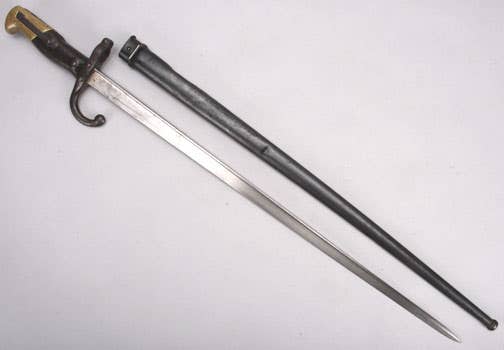
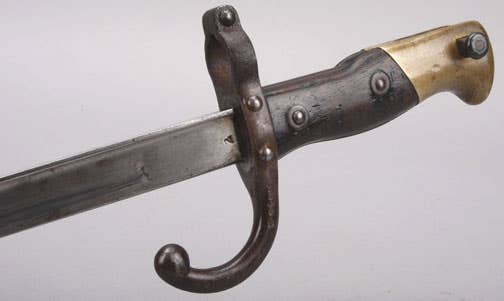

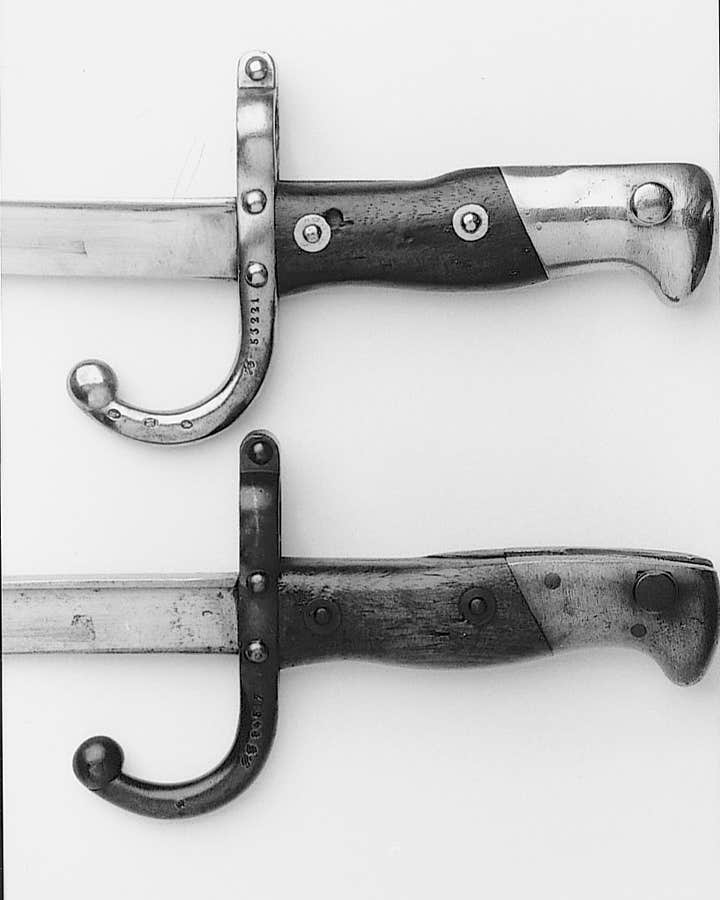
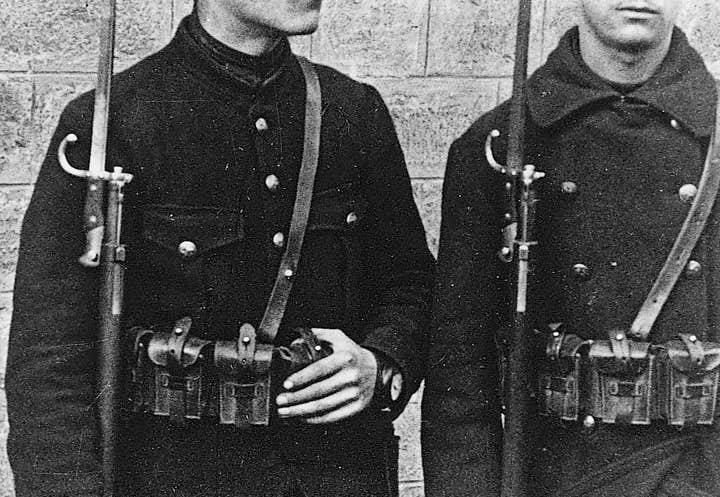
The need to modify the Model 1874 Gras bayonet into a Model 1874/89 (so that it could be affixed to a Model 1889 Mauser rifle) can be explained by looking at the extremities of the barrels of the Mauser rifle and the Mauser carbine allégée. When looking at the Model 1889 Mauser carbine allégée, one can see that there is about 15.5 cm of the barrel jacket that is free (that is to say, there is no stock beneath it). That isn’t the case with the Model 1889 Mauser rifle. This “free” area gave the armourers the possibility to install a bayonet lug for the Gras onto the barrel jacket of the Model 1889 Mauser carbine allégée without any difficulty. The Mauser rifle, however, didn’t allow the same conversion method.
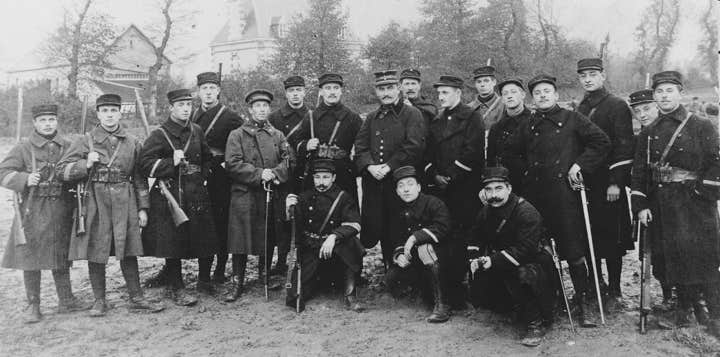
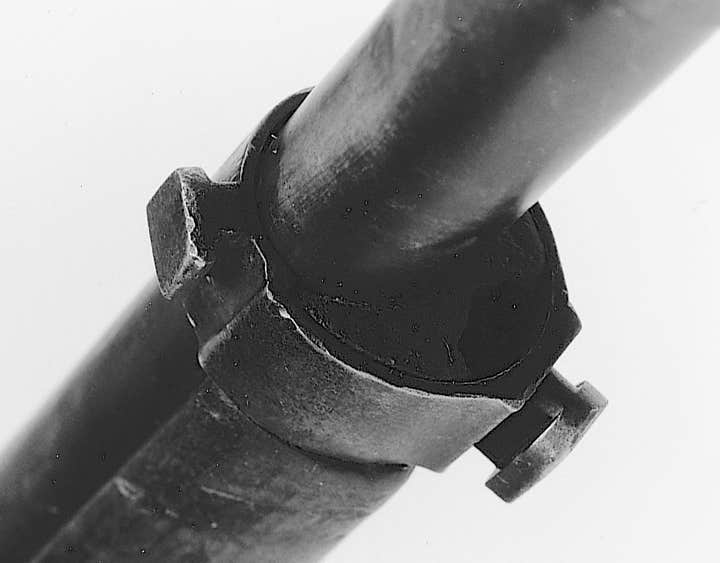
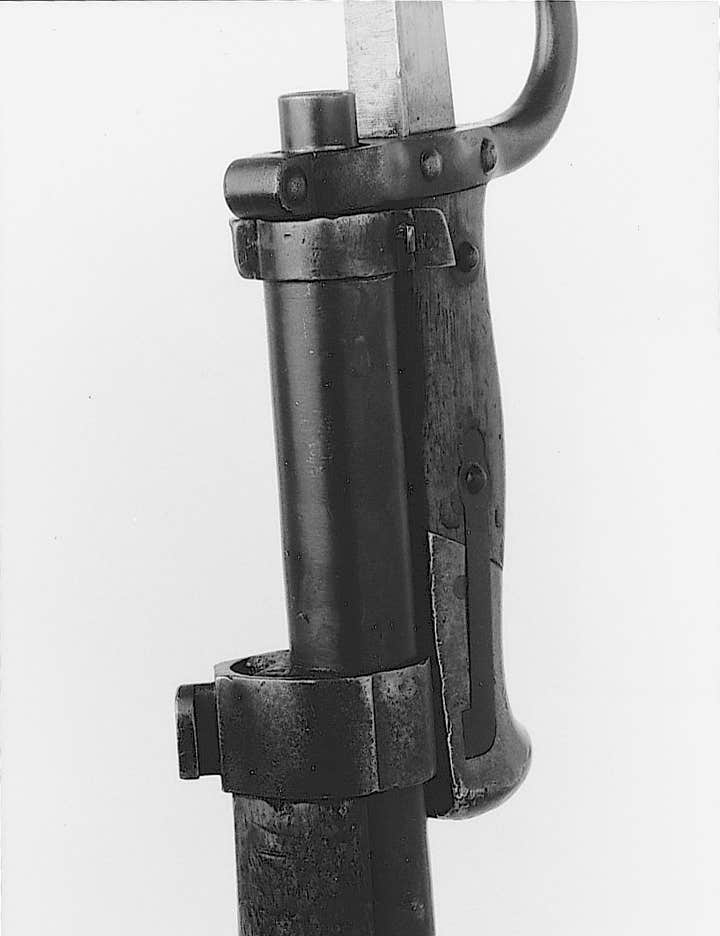
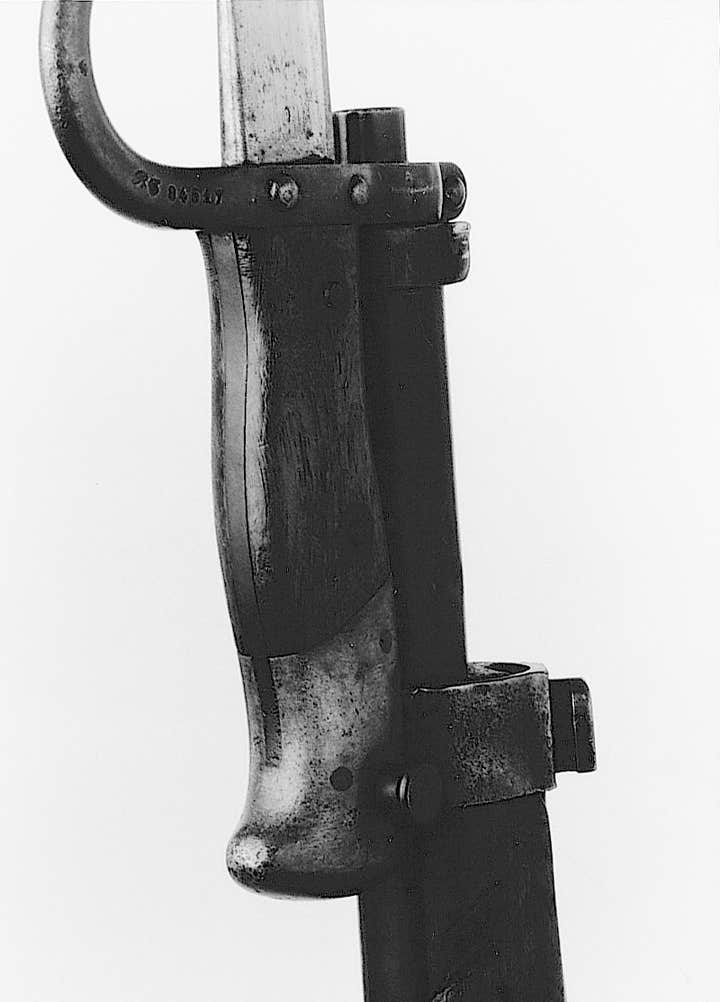
Therefore, the Belgian armourers employed a two-part modification. First, they added an extra bayonet lug on the first barrel band of the rifle (this is the barrel band where the Mauser rifle’s original bayonet lug was mounted). The extra bayonet lug was placed in a “one o’clock” position (as seen from the position of the marksman. The second modification consisted of removing a part of the back-side of the handle of the Model 1874 Gras bayonet without modifying the muzzle ring diameter.
The place of the extra bayonet lug in the one o’clock position was necessary as the T-slot in the back of the handle of the Gras bayonet was not deep enough in relation to the back-side of the handle. If the extra bayonet lug would have been placed in the three o’clock position, than the armourers would have been forced to remove even more of the back of the handle of the Gras bayonet. Such modification would have resulted in a situation where the T-slot no longer would have existed and, as such, wouldn’t have been able to retain the extra bayonet lug.
Originally, it was questioned whether or not they modified weapons were used actually at the front. his answer is only speculative. On the basis of Figure 8 in Part I of this article that shows Belgian cavalry troopers armed with Model Mauser carbines allégée, the author is tempted to say it is possible that the Belgian cavalry used these modified Mauser carbines until there were enough of the Model 1916 Mauser carbines became available. As for the modified Model 1889 Mauser rifles, the author is tempted to say that they were probably only used for the training of recruits or for guard duties. However, it must be considered that the only photos showing these modified rifles that the author has examined were taken during WWI.
THE USE OF GRAS RIFLES AFTER WWI
To most, it was obvious after WWI that the Model 1874 Gras rifle was more than obsolete. This fact didn’t stop the Belgian Army from continuing to use this rifle and bayonet, however. Gras rifles were still used for training purposes as well as a weapon to be used by non-combatant units.
Apart from the Belgian Army, some units of Belgian firemen were also armed with the Model 1874 Gras rifle. Before WWI, there were many units of firemen that were armed with the purpose to maintain—in collaboration with the police—public order if it were necessary. After the armistice, this system was continued but all armed units of firemen had lost their weapons during WWI (see Figure 8) .
This was also the case of the firemen of the city of Aalst. The book De Aalsterse brandweer states that the fire department of the city of Aalst came—through the provincial administration—into possession of 100 rifles to replace those lost during WWI. Since the Aalst fire department was 150 men strong, they still would lack 50 rifles. The city’s mayor demanded that the governor of the province and to the commissioner of the district to intercede in order to obtain another 50 rifles and bayonets.
The weapons arrived at the end of March 1920, but, in June of that same year, the commander of the fire department complained that these rifles were “old Gras rifles” and that they were in bad condition. The administration of the fire department demanded to replace the Gras rifles with 100 Mauser rifles and 60 bayonets for the musicians and clarions. This request was probably granted due to a decision of the Belgian government on July 12, 1937, to dissolve the armed fire-department of Aalst and replace it with an unarmed fire department. This meant that all the weapons that were in the hands of the fire-department had to be sent back to the depot of the Belgian Army in Antwerp. This transfer took place on August 24, 1937—150 Gras rifles, bayonets, and slings were returned, indicating that Aalst had never received the Mauser rifles that it had demanded.
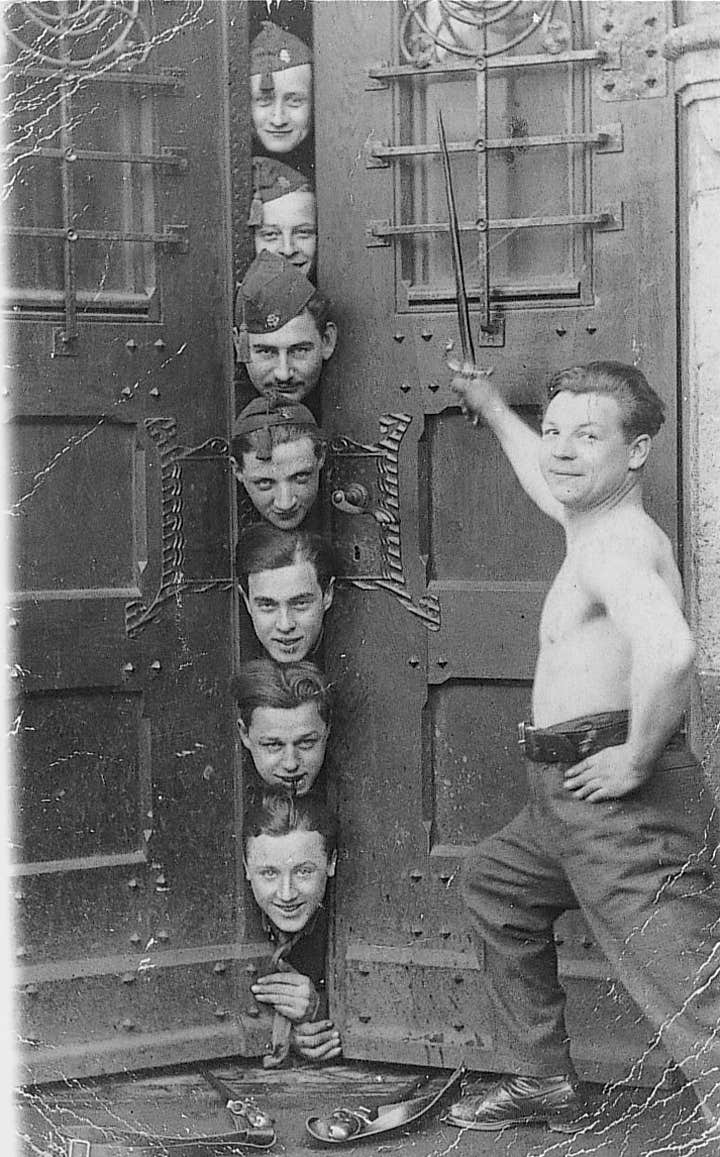
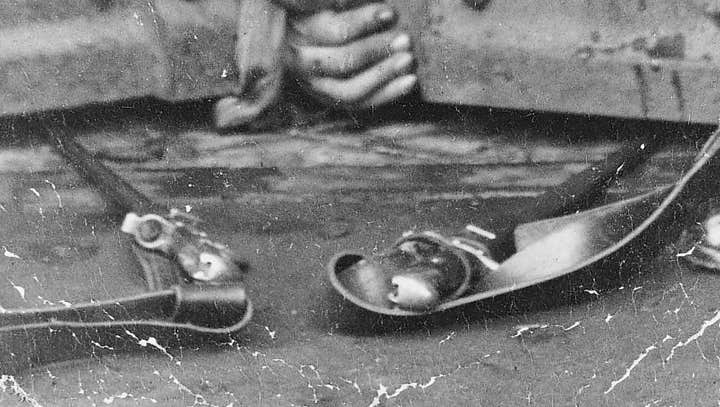
This story of the fire department of the city of Aalst is probably not a unique story. The author believes that other armed fire departments in Belgium were disarmed at the same time. In any case, this example does illustrate that Model 1874 Gras rifles stayed in service in Belgium until the late 1930s.
The Gras rifles that were returned probably were used by the Belgian Army as a reserve. However, it is also possible that some of these weapons had been declared obsolete or destroyed and that some of the bayonets blades were recovered and mounted on handles of the Model 1916 or 1916/35 Belgian Mauser bayonets. Unfortunately, no written record has been located to confirm this working hypothesis. Nevertheless, Model 1916 Belgian Mauser bayonets built with blades from Model 1874 French Gras bayonets do exist.
MODEL 1916 MAUSER BAYONET
The Belgian military, in an effort to recycle obsolete weapons, created a “hybrid”
bayonet for use with the Model 1916 Mauser rifle. Combining the blade of the Model 1874 French Gras bayonet (which was shortened and two sides of the T-shaped blade ground away) with the handle of the Model 1916 Belgian Mauser bayonet, the Belgian military was able to inexpensively provide bayonets to a number of its soldiers.
The hybrid bayonet is known amongst the bayonet collectors as the “Model 1916 Gendarmerie.” The author doesn’t share the opinion that this bayonet was destined to serve in the ranks of the Belgian gendarmerie. No information has been located that proves that this bayonet was made for or even was issued to the Belgian gendarmerie. On the contrary, the author has in his personal collection three examples of this bayonet that are marked as having been issued to the 5th, 11th, and 13th Line Regiments. None of the bayonets of this type that have been examined by the author were marked for use by the Belgian gendarmerie.
It has not been determined when these bayonets were made. Were they made during WWI or in the 1930s when the Belgian Army started rearming? Most of these bayonets that one finds have been heavily blued. This blueing wasn’t done during WWI. Furthermore it appears that the muzzle ring diameter of the bayonet lug of some of these blued bayonets has been reduced from 17.5mm to 15.5mm so that they could be fixed to the Model 1935 and 1936 Mauser rifles. The most accurate nomenclature for these bayonets, therefore, would be “Model 1916 Mauser bayonet with the recycled blade of a Model 1874 French bayonet.” It is possible that blades of the Model 1882 Belgian Comblain bayonet were also used for this modification, but no such examples have been discovered.
CONCLUSION
To summarize this two-fold article, at the time when the Model 1874 Gras rifle was given to the Belgian volunteers, it had already been surpassed by the other infantry weapons currently in service throughout Europe. Despite its small contribution as an infantry weapon on the battlefields in Belgium, the Model 1874 Gras rifle and bayonet played an important role in the training of the Belgian recruits during WWI.
After WWI, the Model 1874 Gras rifle and bayonet continued to serve in the ranks of certain non-combatant units of the Belgian Army and in the ranks of armed units of firemen. Even after some bayonets ceased to exist as an edged weapon as such, their blades continued to be used on the handles of the Belgian Model 1916 Mauser bayonet (many of which were used in the defense of Belgium in 1940).
It is hoped that this article clarifies some of the mystery that surrounds the use of this French weapon by the Belgian military history. In so doing, the author hopes that he has paid a degree of homage to the men who used it in the defense of Belgium.
For More info:
Boomputte, E., “La baïonnette modèle 1889 belge, fabrication Hopkins & Allen,” Le Journal de l'Association Française des Collectionneurs de Baïonnettes, No. 9 (Avril 1999), 35-40.
—, “Les porte-fourreaux de baïonnettes belges pour baïonnettes françaises durant la Première Guerre Mondiale,” Le Journal de l'Association Française des Collectionneurs de Baïonnettes, No. 12 (Janvier 2000), 25-31.
—, “Les baïonnettes Gras utilisées réglementairement par les forces armées belges en 14-18,” Le Journal de l'Association Française des Collectionneurs de Baïonnettes, No. 14 (Juillet 2000), 2-4.
Chatelle, A. L'effort belge en France pendant la guerre (1914-1918), Firmin-Didot et Cie, Paris, 1934.
Ghysens, J., De Aalsterse brandweer, N.V. De Muyter, Deinze, 1996.
n.a., De Belgische reglementaire vuurwapens sedert 1830, Brussel, Gemeentekrediet, 1988.
n.a., Geschiedkundig Overzicht der 5de, 15de en 25ste Linieregimenten, Jos. De Volder, Antwerpen, 1936(?).
n.a. Léopold II et la Force Publique du Congo- Leopold II en de Openbare Weermacht van Kongo, KKOOVA, Brussel, 1985.
You may also like:
*As an Amazon Associate, Military Trader / Military Vehicles earns from qualifying purchases








